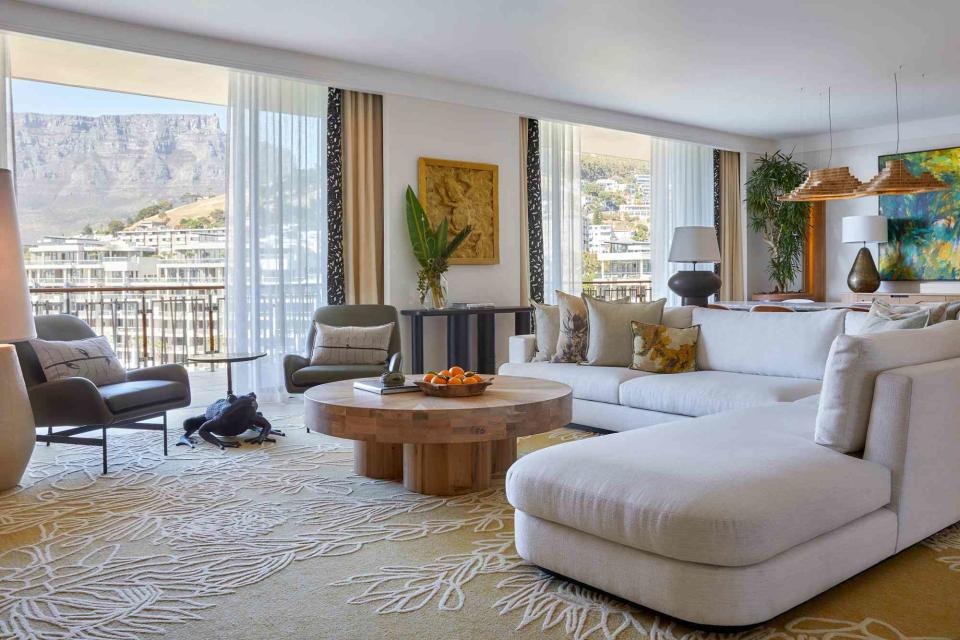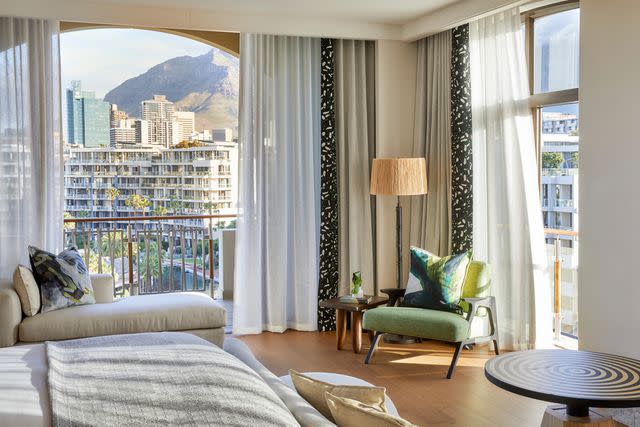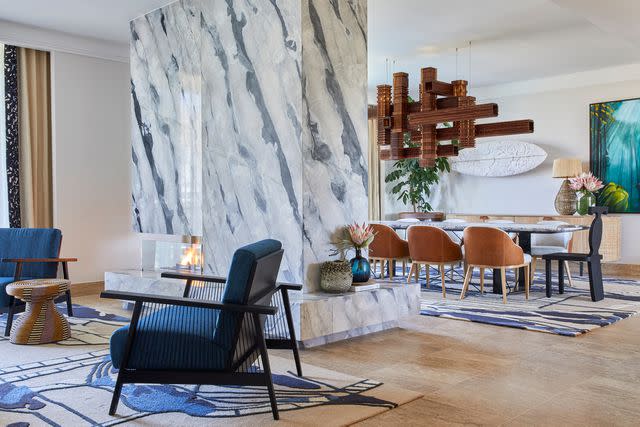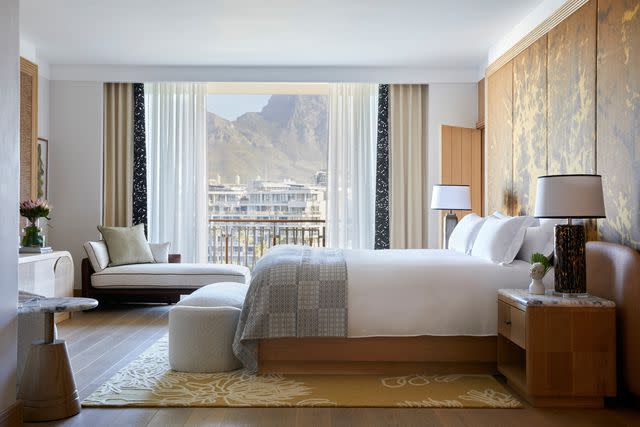This Designer Worked on South Africa's First Post-apartheid Museum — and She Just Redesigned One of Cape Town's Most Luxurious Resorts
Inge Moore's career started with a historic project at the country's first post-apartheid museum. Most recently, she's redesign the Mother City's most luxurious resort.

Muza Lab
The newly renovated One&Only Cape Town feels like a study of the Mother City — its rich cultural history, contemporary art scene, and natural beauty. The moment guests step inside the elegant waterfront property, everything around them — including the panoramic views of Table Mountain — celebrates Cape Town and its place in modern-day South Africa.
In the lobby, a bold sculpture by Cape Town–based Kenya–born Stanislaw Trzebinski invokes a local legend about the creation of Table Mountain. And in the rooms, the decor, color palette, and commissioned artwork highlight the Great African Seaforest, a dynamic ecosystem (and one of the new Seven Wonders of the World) off the coast of Cape Town. Each space, whether a private accommodation or public area, is a piece of an elaborate puzzle that tells the story of Cape Town as a vibrant cultural hub.
"A hotel should be the showcase for the local area," Inge Moore, principal designer of Muza Lab, the international design studio behind the renovation, told Travel + Leisure.

Muza Lab
To hospitality insiders, Moore needs no introduction. Her impressive portfolio of clients includes some of the luxury industry's most exquisite properties in all corners of the world: Switzerland's The Alpina Gstaad; Copacabana Palace, A Belmond Hotel, Rio de Janeiro in Brazil; Savute Elephant Lodge, A Belmond Safari, Botswana; Six Senses Kanuhura in the Maldives; and the upcoming One&Only Aesthesis in Athens.
Born in Johannesburg, but a long-time resident of London, she learned early on in her career that design can be a powerful storytelling tool. In 1994, just as apartheid fell in South Africa, MuseumAfrica relocated to a new building in her hometown, and Moore was tasked with helping the museum's art department create the new exhibition spaces.
"What was so wonderful about that is that you dealt with all the different curators that put this museum together — archeology, costume, photography, music, geology. So I think that really widened my approach and taught me that you have to tell a story with everything," Moore explained.
This would ultimately define her approach to design. (She also credits her work at the country's first post-apartheid museum with teaching her the social impact that thoughtful design could have as people constantly interact with it.)

Muza Lab
So with a clear vision and decades of experience, she jumped at the chance to transform Cape Town's most luxurious urban resort.
"I wanted it to be soft. And I wanted it to feel residential, to bring in the natural beauty of Cape Town — the plants that are under and over the water, the stars, the nature, and then through that, bringing in the crafts, specifically [those sourced from] Cape Town," Moore said.
Boasting 133 of the largest accommodations in the city with panoramic views of the marina at the elegant Victoria & Alfred Waterfront district and Table Mountain, the resort debuted in 2009 to international acclaim. It houses South Africa's only Nobu restaurant, a multilevel wine cellar with thousands of bottles and a tasting room, and a spa on its own private island.

Muza Lab
And while the resort's original design did feature subtle references to Africa — such as textiles, dark woods, and oversized windows with heart-stopping vistas of Table Mountain — Moore sought to instill a deeper sense of place while dressing the spaces in a much lighter palette. She relied on local suppliers and artisans to create new furnishings made from oak and lighter-hued timbers. She then juxtaposed them with bold accent pieces, drawing inspiration from the vibrant arts and crafts of the local Xhosa tribes.
Patterned Kente textiles, native to Ghana, greet travelers in the guest rooms' entryway. Beaded pots by Zimbabwe-born Richard Madongwe add texture and mirror frames by Johannesburg-based Coote and Wench have been hand carved by emerging wood sculptor Ben Tuge, with designs based on the kelp forests of Cape Town. The headboards in the bedrooms were upholstered in printed fabrics inspired by sea algae and created with the assistance of the South African Biodiversity Institute.

Muza Lab
The resort's two signature suites have been completely reimagined as sophisticated places of refuge through the art, the natural materials, and the distinct color palettes inspired by the shades of the ocean, the kelp forests, and Table Mountain. Moore's redesign, and One&Only Cape Town's DNA, heavily emphasize local talent.
The resort is also home to the Cape Town outpost of the Melrose Gallery, which has an extensive collection of pieces by local creatives. For the redesign, Moore enlisted the help of emerging and established artisans to create custom art that capture the region’s natural beauty "while providing opportunities for training and job creation," according to a press release sent to T+L.
For example, Meshack Masuku, who runs a ceramics studio out of the small beach town of Kenton-on-Sea, uses clay made from local kaolin sourced from one of the largest deposits in South Africa. He employed three more artists to create 89 pieces that can now be found in the guest rooms.
"It's so important to me that we protect what we have, and not just the nature around us but also the crafts that then come from it. And we need to educate people to appreciate it," Moore said. "People come on a holiday, and if their surroundings interest them, then that creates conversation, and conversation then leads to education."
For more Travel & Leisure news, make sure to sign up for our newsletter!
Read the original article on Travel & Leisure.

